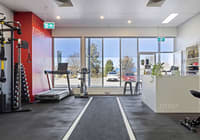
The best commercial buys for small investors in 2017
With yields for residential property in some capital cities squeezed very tight, small investors with an eye for a diversified portfolio are increasingly turning to commercial assets, agents say.
Returns for some of these properties can be double that of houses and apartments, with the best areas to purchase being close to the metropolitan centres.
LJ Hooker Commercial South Sydney director William Tong said the industrial sector had experienced growth over the past 18 to 24 months due to a reduction in properties for sale.
”A lot of these industrial sites (in South Sydney) have been bought and converted into residential sites,” he said.
”So the number of businesses in the market hasn’t shrunk – as a matter of fact it’s grown – but the supply has shrunk, and then you couple that with lower interest rates, which is perfect for an owner-occupier to borrow money and lock it in for five years. It presents a lot of opportunities for people to buy.”
Strata offices were also providing opportunities, with potential yields in the 5.5 to 6 per cent range as well as capital growth prospects, Mr Tong said.
And he suggested the best locations to invest in commercial assets in 2017 were all about proximity to Sydney’s CBD.
”Real estate is about location, location, location. Anything within seven kilometres of the CBD is always a safe bet,” he said.
”Anything within the fringe, within the inner west or South Sydney – those markets are always buoyant, always safe, and there’s always demand for it.”
In Melbourne the commercial sector is providing ample opportunities for small investors and will continue to do so in 2017, according to the experts.
CBRE City Fringe Metropolitan Investments director Sandro Peluso said prime retail assets had experienced strong capital appreciation due to its potentially lower vacancy rate periods.
He said the past year had seen a noticeable move by investors into health-related commercial assets.
”The trend that I’ve been seeing for the past six to 12 months is the appetite for medical-related type of investments and my feeling is that 2017 will probably see investors really looking to invest in the health sector more so than ever before,” he said.
”Because we’re seeing that the returns are far greater, you invest in good locations you’ll see capital appreciation, and probably one aspect that investors are starting to see with the medical side of things is it’s being seen as a non-cyclical asset.”
He said the security of well-known medical groups, such as pathologists and dentists, as tenants, was underpinning demand for that particular commercial asset.
Small investors should consider Melbourne’s inner-eastern corridor, Mr Peluso said, but the location of medical-related assets was not as important as with general commercial property investment.
In the southeast Queensland commercial market, small investors in the $2 to $5 million price range accounted for about 50 per cent of all office and industrial transactions in 2016, according to Savills.
”With all but two sales, the fringe’s ‘urban renewal’ precinct – which includes suburbs such as Fortitude Valley, Bowen Hills and Newstead – was the most commonly sought-after (office) area,” Savills’ Queensland Research Consultancy associate director Yvette Burton said.
”The ‘Trade Coast’ precinct was the most popular with private investors, with 11 of the 34 (industrial) properties bought under $5 million purchased there.”
Ms Burton said retail was also in demand from small investors, with shops – which also recorded a passing yield of 7 per cent in 2016 – the most popular.
But Savills’ Queensland Commercial Sales associate director Gregory Woods said small investors in southeast Queensland still needed to stick to the mantra of ”location, location”.
”A commercial property in a sought-after location will typically achieve higher long-term occupancy levels and stronger capital growth prospects with the trade-off being the lower initial yield as a result of its underlying fundamentals,” he said.
”Every buyer has different preferences and buying parameters, which are a function of their individual circumstances, but where possible I advocate a lower yielding prime property over a high yielding secondary property.”












